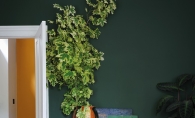
Building a home or planning a remodel? Click here for our home and garden resource guide.
Velvet has been around for ages. Think nobility and royalty. While the use of this elegant fabric on furniture took a backseat for a time, it’s popular again with a swanky, elevated charisma of design confidence. But use caution so as not to tip toward tacky and away from on trend—be mindful of dancing too close to velour.
Here’s what you need to know. Velvet can be easily incorporated as an accent. Think drapery, ottomans, pillows, small furniture, decorative elements and the like. While small scale is a safe bet, there is nothing that governs a room with bespoke confidence quite like a velvet-covered sofa or chaise lounge. While it’s tempting to go with a larger statement piece, be sure to consider how and where it will be used and by whom. This upscale fabric might not be suited for a young family’s gathering space or casual eating areas.
Velvet is generally made from silk, cotton, and fibers from linen, mohair and wool can be used, though some manufacturers use polyester. Its plush texture almost commands deep, rich color stories but velvet accepts quieter, gentler hues, too. Its pile can be cut into shapes, which lend themselves to curtains or pillow/cushion covers.
Is it possible to love your velvet furniture and use it? Maintaining velvet can take some extra effort, but it’s worth it to achieve that level of elegance or even cheekiness your design palate craves. Besides, if well-made and maintained, many velvet pieces can and should be preserved for generations. Some homeowners appreciate the worn look of velvet, which speaks in subtle tones to the piece’s history—or secrets!
If you’re unsure about how to add a velvet element into your living spaces, consult a design expert, who can offer invaluable direction and insight.
MORE FROM THE 2019 HOME AND GARDEN BOOK
Add a Luxurious Centerpiece to Your Bathroom with a Soaker Tub
How to Use Pantone's Color of the Year in Your Home
How to Create the Perfect Paver Patio









